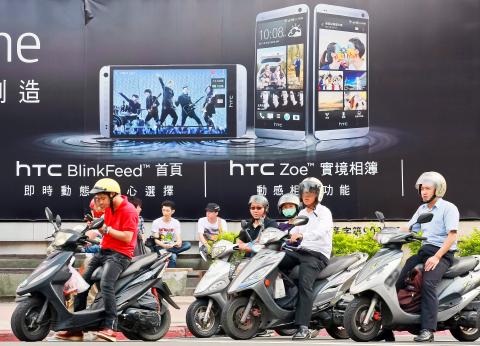As the smartphone market has come to a saturated stage where players face falling margin issues, HTC Corp (宏達電) could use mobile applications to attract more consumers to its devices, analysts said.
Mega Investment Trust Co (兆豐國際投信) said HTC could follow Apple Inc’s model of making profits from selling mobile apps in its App Store. Chinese smartphone maker Xiaomi Corp (小米) and telecom equipment maker Huawei (華為) have already followed in Apple’s footsteps and generated significant profits from app stores, it said.
Enjoying the advantages of a large home market with strong demand for both low and high-end smartphones, Xiaomi and Huawei have developed a variety of gaming, social networking and news publishing apps for consumers to download in their own app stores, which are installed in their smartphones, Mega analyst Kevin Hsu (許鈞雄) said by telephone on Friday.

Photo: Maurice Tsai, Bloomberg
Despite confronting challenges in expanding its market share in China, HTC could still follow the move and develop Chinese-language apps in its own app store, Hsu said.
With creative applications built in high-quality smartphone products, HTC might find it easier to attract more consumers in the Chinese market, instead of striving to balance market share and profitability, he added.
“Even Huawei and Xiaomi have realized making smartphones running on Google Inc’s free Android platform generates less and less margin. HTC should not keep pushing high-end models, but come up with new profit sources before it’s too late,” Hsu said.
On July 5, HTC reported a 23.87 percent month-on-month sales decline to NT$22.07 billion (US$738.86 million) last month from NT$29 billion in May, and the company’s One flagship model failed to lift the company’s second-quarter sales to meet the market consensus of NT$75 billion, reaching only NT$70.7 billion.
“HTC’s second-quarter operating margin is disastrous, reflecting the fact that the high-end new One flagship smartphone is hardly driving up the company’s sales after only two months since shipments started,” Hsu said.
“Analysts expected the new One, with its innovative features, to sustain HTC’s sales growth for at least two months as a high-end smartphone model,” Hsu said.
“However, the company’s earlier-than-expected month-on-month sales drop proved high-end smartphone models are no more attractive to the market because handheld devices have become like cheap commodities to everyone,” he added.
In a report released on Thursday, JPMorgan Securities (Asia Pacific) Ltd analyst Alvin Kwock (郭彥麟) said Samsung Electronics Co, the world’s largest smartphone maker by shipments, had cut the price of its flagship Galaxy S4 smartphone by more than 20 percent only three months after its launch.
The typical price drop for smartphones is between 5 and 8 percent per quarter, Kwock said.
However, Samsung, LG Electronics Inc and Sony Corp have lowered their prices by between 12 percent and 20 percent for their Galaxy S4, Optimus G Pro and Xperia XL models respectively, he said.
This has pressured HTC to enter the same pricing competition and proved that the product cycle of high-end smartphones is getting shorter, he added.

WEAKER ACTIVITY: The sharpest deterioration was seen in the electronics and optical components sector, with the production index falling 13.2 points to 44.5 Taiwan’s manufacturing sector last month contracted for a second consecutive month, with the purchasing managers’ index (PMI) slipping to 48, reflecting ongoing caution over trade uncertainties, the Chung-Hua Institution for Economic Research (CIER, 中華經濟研究院) said yesterday. The decline reflects growing caution among companies amid uncertainty surrounding US tariffs, semiconductor duties and automotive import levies, and it is also likely linked to fading front-loading activity, CIER president Lien Hsien-ming (連賢明) said. “Some clients have started shifting orders to Southeast Asian countries where tariff regimes are already clear,” Lien told a news conference. Firms across the supply chain are also lowering stock levels to mitigate

IN THE AIR: While most companies said they were committed to North American operations, some added that production and costs would depend on the outcome of a US trade probe Leading local contract electronics makers Wistron Corp (緯創), Quanta Computer Inc (廣達), Inventec Corp (英業達) and Compal Electronics Inc (仁寶) are to maintain their North American expansion plans, despite Washington’s 20 percent tariff on Taiwanese goods. Wistron said it has long maintained a presence in the US, while distributing production across Taiwan, North America, Southeast Asia and Europe. The company is in talks with customers to align capacity with their site preferences, a company official told the Taipei Times by telephone on Friday. The company is still in talks with clients over who would bear the tariff costs, with the outcome pending further

Six Taiwanese companies, including contract chipmaker Taiwan Semiconductor Manufacturing Co (TSMC, 台積電), made the 2025 Fortune Global 500 list of the world’s largest firms by revenue. In a report published by New York-based Fortune magazine on Tuesday, Hon Hai Precision Industry Co (鴻海精密), also known as Foxconn Technology Group (富士康科技集團), ranked highest among Taiwanese firms, placing 28th with revenue of US$213.69 billion. Up 60 spots from last year, TSMC rose to No. 126 with US$90.16 billion in revenue, followed by Quanta Computer Inc (廣達) at 348th, Pegatron Corp (和碩) at 461st, CPC Corp, Taiwan (台灣中油) at 494th and Wistron Corp (緯創) at

NEGOTIATIONS: Semiconductors play an outsized role in Taiwan’s industrial and economic development and are a major driver of the Taiwan-US trade imbalance With US President Donald Trump threatening to impose tariffs on semiconductors, Taiwan is expected to face a significant challenge, as information and communications technology (ICT) products account for more than 70 percent of its exports to the US, Chung-Hua Institution for Economic Research (CIER, 中華經濟研究院) president Lien Hsien-ming (連賢明) said on Friday. Compared with other countries, semiconductors play a disproportionately large role in Taiwan’s industrial and economic development, Lien said. As the sixth-largest contributor to the US trade deficit, Taiwan recorded a US$73.9 billion trade surplus with the US last year — up from US$47.8 billion in 2023 — driven by strong